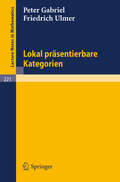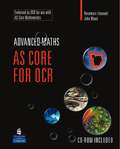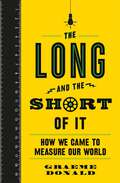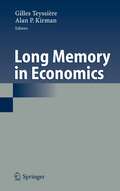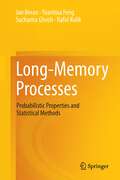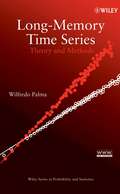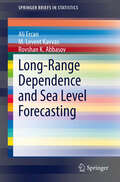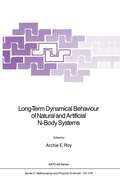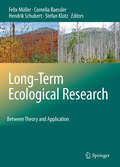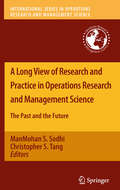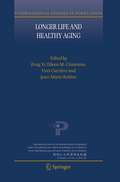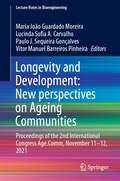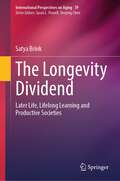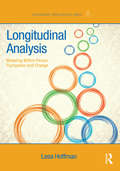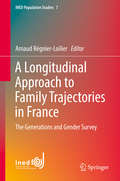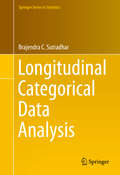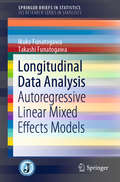- Table View
- List View
Lokal präsentierbare Kategorien (Lecture Notes in Mathematics #221)
by Peter Gabriel Friedrich UlmerLondman Advanced Maths: AS Core for OCR (PDF)
by John Wood Rosemary EmanuelLongman Advanced Mathematics is a series of comprehensive texts, with books for each of the OCR main courses that started in September 2004 The series develops core mathematical skills through an abundance of clear worked examples and progressive exercises, backed up by focused exam question practise and sample module papers.Covers all the A2 Core Modules C1 and C2 in one book.
Long and short, wide and narrow (tactile)
by Adrian FarnsworthThis is an eight-page tactile document of exercises intended to teach the concepts of long and short, and wide and narrow.
The Long and the Short of It: How We Came to Measure Our World
by Graeme DonaldWe’ve always measured the world around us, from how big things are, to how fast they go, how much they’re worth and practically everything in between. But who decided how we do it, and why?The Long and the Short of It takes us back in time to discover the origins and evolution of a huge variety of different units of measurement. On the way it answers such questions as:Why do we measure time in units of 60? How do you determine the height of a mountain when sea level keeps changing? Why did the length of a mile once depend on where you came from?What’s the width of a horse’s backside got to do with NASA’s booster rockets? Packed with fascinating stories, this is an intriguing guide to the many systems of measurement that make sense of our daily lives, from pounds and parsecs to bushels and barricades.
Long-Memory Processes: Probabilistic Properties and Statistical Methods
by Jan Beran Yuanhua Feng Sucharita Ghosh Rafal KulikLong-memory processes are known to play an important part in many areas of science and technology, including physics, geophysics, hydrology, telecommunications, economics, finance, climatology, and network engineering. In the last 20 years enormous progress has been made in understanding the probabilistic foundations and statistical principles of such processes. This book provides a timely and comprehensive review, including a thorough discussion of mathematical and probabilistic foundations and statistical methods, emphasizing their practical motivation and mathematical justification. Proofs of the main theorems are provided and data examples illustrate practical aspects. This book will be a valuable resource for researchers and graduate students in statistics, mathematics, econometrics and other quantitative areas, as well as for practitioners and applied researchers who need to analyze data in which long memory, power laws, self-similar scaling or fractal properties are relevant.
Long-Memory Time Series: Theory and Methods (Wiley Series in Probability and Statistics #662)
by Wilfredo PalmaA self-contained, contemporary treatment of the analysis of long-range dependent data Long-Memory Time Series: Theory and Methods provides an overview of the theory and methods developed to deal with long-range dependent data and describes the applications of these methodologies to real-life time series. Systematically organized, it begins with the foundational essentials, proceeds to the analysis of methodological aspects (Estimation Methods, Asymptotic Theory, Heteroskedastic Models, Transformations, Bayesian Methods, and Prediction), and then extends these techniques to more complex data structures. To facilitate understanding, the book: Assumes a basic knowledge of calculus and linear algebra and explains the more advanced statistical and mathematical concepts Features numerous examples that accelerate understanding and illustrate various consequences of the theoretical results Proves all theoretical results (theorems, lemmas, corollaries, etc.) or refers readers to resources with further demonstration Includes detailed analyses of computational aspects related to the implementation of the methodologies described, including algorithm efficiency, arithmetic complexity, CPU times, and more Includes proposed problems at the end of each chapter to help readers solidify their understanding and practice their skills A valuable real-world reference for researchers and practitioners in time series analysis, economerics, finance, and related fields, this book is also excellent for a beginning graduate-level course in long-memory processes or as a supplemental textbook for those studying advanced statistics, mathematics, economics, finance, engineering, or physics. A companion Web site is available for readers to access the S-Plus and R data sets used within the text.
Long-Range Dependence and Sea Level Forecasting (SpringerBriefs in Statistics)
by Ali Ercan M. Levent Kavvas Rovshan K. AbbasovThis study shows that the Caspian Sea level time series possess long range dependence even after removing linear trends, based on analyses of the Hurst statistic, the sample autocorrelation functions, and the periodogram of the series. Forecasting performance of ARMA, ARIMA, ARFIMA and Trend Line-ARFIMA (TL-ARFIMA) combination models are investigated. The forecast confidence bands and the forecast updating methodology, provided for ARIMA models in the literature, are modified for the ARFIMA models. Sample autocorrelation functions are utilized to estimate the differencing lengths of the ARFIMA models. The confidence bands of the forecasts are estimated using the probability densities of the residuals without assuming a known distribution.There are no long-term sea level records for the region of Peninsular Malaysia and Malaysia’s Sabah-Sarawak northern region of Borneo Island. In such cases the Global Climate Model (GCM) projections for the 21st century can be downscaled to the Malaysia region by means of regression techniques, utilizing the short records of satellite altimeters in this region against the GCM projections during a mutual observation period.This book will be useful for engineers and researchers working in the areas of applied statistics, climate change, sea level change, time series analysis, applied earth sciences, and nonlinear dynamics.
Long-Term Dynamical Behaviour of Natural and Artificial N-Body Systems (Nato Science Series C: #246)
by Archie E. RoyThe reader will find in this volume the Proceedings of the NATO Advanced Study Institute held in Cortina d'Ampezzo, Italy between August 3 and August 13, 1987 under the title "Long Term Dynamical Behaviour of Natural and Artificial N-body Systems". The Institute was the latest in a series held in 1972, 1975, 1978, 1981, 1984 in dynamical astronomy, theoretical mechanics and celestial mechanics under the Directorship of Professor Victor Szebehely. These previous institutes, held in high esteem by the international community of research workers, have resulted in a series of well-received and valuable Proceedings. In correspondence with Professor Szebehely and in long discussions with him in Colorado in August 1985, I agreed to his request that I undertake the preparation of a new ASI. I was happy to do so knowing I could call upon his vast experience in overseeing such ASI's. The last quarter century has been a period in which increasingly rapid progress has been made in celestial mechanics and related subjects not only because of the appearance of new problems urgently requiring solution but also because of the advent of new analytical techniques and powerful computer hardware and software.
Long-Term Ecological Research: Between Theory and Application
by Felix Müller Cornelia Baessler Hendrik Schubert Stefan KlotzEcosystems change on a multitude of spatial and temporal scales. While analyses of ecosystem dynamics in short timespans have received much attention, the impacts of changes in the long term have, to a great extent, been neglected, provoking a lack of information and methodological know-how in this area. This book fills this gap by focusing on studies dealing with the investigation of complex, long-term ecological processes with regard to global change, the development of early warning systems, and the acquisition of a scientific basis for strategic conservation management and the sustainable use of ecosystems. Within this book, theoretical ecological questions of long-term processes, as well as an international dimension of long-term monitoring, observations and research are brought together. The outcome is an overview on different aspects of long-term ecological research. Aquatic, as well as terrestrial ecosystems are represented.
Long-Term Health State Estimation of Energy Storage Lithium-Ion Battery Packs
by Qi Huang Shunli Wang Zonghai Chen Ran Xiong Carlos Fernandez Daniel-I. StroeThis book investigates in detail long-term health state estimation technology of energy storage systems, assessing its potential use to replace common filtering methods that constructs by equivalent circuit model with a data-driven method combined with electrochemical modeling, which can reflect the battery internal characteristics, the battery degradation modes, and the battery pack health state. Studies on long-term health state estimation have attracted engineers and scientists from various disciplines, such as electrical engineering, materials, automation, energy, and chemical engineering. Pursuing a holistic approach, the book establishes a fundamental framework for this topic, while emphasizing the importance of extraction for health indicators and the significant influence of electrochemical modeling and data-driven issues in the design and optimization of health state estimation in energy storage systems. The book is intended for undergraduate and graduate students who are interested in new energy measurement and control technology, researchers investigating energy storage systems, and structure/circuit design engineers working on energy storage cell and pack.
A Long View of Research and Practice in Operations Research and Management Science: The Past and the Future (International Series in Operations Research & Management Science #148)
by ManMohan S. Sodhi Christopher S. TangFrom the Foreword by Marshall Fisher, The Wharton School, University of Pennsylvania: As generation of academics and practitioners follows generation, it is worthwhile to compile long views of the research and practice in the past to shed light on research and practice going forward. This collection of peer-reviewed articles is intended to provide such a long view. This book contains a collection of chapters written by leading scholars/practitioners who have continued their efforts in developing and/or implementing innovative OR/MS tools for solving real world problems. In this book, the contributors share their perspectives about the past, present and future of OR/MS theoretical development, solution tools, modeling approaches, and applications. Specifically, this book collects chapters that offer insights about the following topics: • Survey articles taking a long view over the past two or more decades to arrive at the present state of the art while outlining ideas for future research. Surveys focus on use of a particular OR/MS approach, e.g., mathematical programming (LP, MILP, etc.) and solution methods for particular family of application, e.g., distribution system design, distribution planning system, health care. • Autobiographical or biographical accounts of how particular inventions (e.g., Structured Modeling) were made. These could include personal experiences in early development of OR/MS and an overview of what has happened since. • Development of OR/MS mathematical tools (e.g., stochastic programming, optimization theory). • Development of OR/MS in a particular industry sector such as global supply chain management. • Modeling systems for OR/MS and their development over time as well as speculation on future development (e.g., LINDO, LINGO, and What’sBest!) • New applications of OR/MS models (e.g., happiness) The target audience of this book is young researchers, graduate/advanced undergraduate students from OR/MS and related fields like computer science, engineering, and management as well as practitioners who want to understand how OR/MS modeling came about over the past few decades and what research topics or modeling approaches they could pursue in research or application.
Longer Life and Healthy Aging (International Studies in Population #2)
by Yi Zeng Eileen M. Crimmins Yves Carrière Jean-Marie RobineA fundamental issue facing the global community is meeting the challenges of population aging and achieving healthy aging to maintain an active older population and reduce the number of disabled people. The focus of this book is on theoretical issues and empirical findings related to trends and determinants of healthy aging, including factors related to "healthy longevity" of the oldest-old, aged 80 and over. The group is the most rapidly increasing elderly sub-population and is most likely to need assistance in daily living in all countries. Chapters include both longitudinal and cross-sectional data from North America, Europe, and Asia in country-specific studies and cross-national comparisons. Part I focuses on the definition, components, concepts, measurements, and determinants of healthy aging, and discusses the trends and patterns of disability and healthy life expectancy at the macro level. Part II addresses individual healthy aging, including its biological and socio-demographic aspects. Part III focuses on issues concerning the family and healthy aging, and Part IV explores formal and informal care for healthy aging through governmental policy interventions and community service programs.
Longevity and Development: Proceedings of the 2nd International Congress Age.Comm, November 11–12, 2021 (Lecture Notes in Bioengineering)
by Maria João Guardado Moreira Lucinda Sofia A. Carvalho Paulo J. Sequeira Gonçalves Vítor Manuel Barreiros PinheiraThis book focuses on the dynamic process of aging and on interventions to support the development of older and integrated societies, from a multidisciplinary point of view. Gathering contributions from researchers and professionals with different backgrounds, including social and health sciences, education, engineering and IT, biology, geography and environmental science, it aims at understanding the phenomenon of population aging, in order to contribute to the development of future functional communities, fostering well-being and autonomy of the elderly, their integration and participation. Based on the proceedings of the 2nd International Congress Age.Comm Longevity and Development, organised online on November 11-12, 2021, from Castelo Branco, Portugal, this book addresses a wide range of specialists dealing with the process of aging, integration and community development in the societies of the future.
The Longevity Dividend: Later Life, Lifelong Learning and Productive Societies (International Perspectives on Aging #39)
by Satya BrinkThis book offers global evidence about the increasing longevity, its consequences and its potential for societal benefits. Based on statistics, academic literature, policy initiatives and numerous country experiences, it explains the interconnected effects of a longer later life, lifelong learning and more productive societies. This larger picture shows how the future can be managed by making strategic choices today. Choosing the right policies allows gaining the maximum benefits from the longevity dividend for current and future generations. This book explains how investing in lifelong learning can enrich the longevity dividend. It gives valuable insights for policy advisors, decision makers, researchers, health professionals, practitioners, students of aging and late life educators.
Longitudinal Analysis: Modeling Within-Person Fluctuation and Change (Multivariate Applications Series)
by Lesa HoffmanLongitudinal Analysis provides an accessible, application-oriented treatment of introductory and advanced linear models for within-person fluctuation and change. Organized by research design and data type, the text uses in-depth examples to provide a complete description of the model-building process. The core longitudinal models and their extensions are presented within a multilevel modeling framework, paying careful attention to the modeling concerns that are unique to longitudinal data. Written in a conversational style, the text provides verbal and visual interpretation of model equations to aid in their translation to empirical research results. Overviews and summaries, boldfaced key terms, and review questions will help readers synthesize the key concepts in each chapter. Written for non-mathematically-oriented readers, this text features: A description of the data manipulation steps required prior to model estimation so readers can more easily apply the steps to their own data An emphasis on how the terminology, interpretation, and estimation of familiar general linear models relates to those of more complex models for longitudinal data Integrated model comparisons, effect sizes, and statistical inference in each example to strengthen readers’ understanding of the overall model-building process Sample results sections for each example to provide useful templates for published reports Examples using both real and simulated data in the text, along with syntax and output for SPSS, SAS, STATA, and Mplus at www.PilesOfVariance.com to help readers apply the models to their own data The book opens with the building blocks of longitudinal analysis—general ideas, the general linear model for between-person analysis, and between- and within-person models for the variance and the options within repeated measures analysis of variance. Section 2 introduces unconditional longitudinal models including alternative covariance structure models to describe within-person fluctuation over time and random effects models for within-person change. Conditional longitudinal models are presented in section 3, including both time-invariant and time-varying predictors. Section 4 reviews advanced applications, including alternative metrics of time in accelerated longitudinal designs, three-level models for multiple dimensions of within-person time, the analysis of individuals in groups over time, and repeated measures designs not involving time. The book concludes with additional considerations and future directions, including an overview of sample size planning and other model extensions for non-normal outcomes and intensive longitudinal data. Class-tested at the University of Nebraska-Lincoln and in intensive summer workshops, this is an ideal text for graduate-level courses on longitudinal analysis or general multilevel modeling taught in psychology, human development and family studies, education, business, and other behavioral, social, and health sciences. The book’s accessible approach will also help those trying to learn on their own. Only familiarity with general linear models (regression, analysis of variance) is needed for this text.
Longitudinal Analysis: Modeling Within-Person Fluctuation and Change (Multivariate Applications Series)
by Lesa HoffmanLongitudinal Analysis provides an accessible, application-oriented treatment of introductory and advanced linear models for within-person fluctuation and change. Organized by research design and data type, the text uses in-depth examples to provide a complete description of the model-building process. The core longitudinal models and their extensions are presented within a multilevel modeling framework, paying careful attention to the modeling concerns that are unique to longitudinal data. Written in a conversational style, the text provides verbal and visual interpretation of model equations to aid in their translation to empirical research results. Overviews and summaries, boldfaced key terms, and review questions will help readers synthesize the key concepts in each chapter. Written for non-mathematically-oriented readers, this text features: A description of the data manipulation steps required prior to model estimation so readers can more easily apply the steps to their own data An emphasis on how the terminology, interpretation, and estimation of familiar general linear models relates to those of more complex models for longitudinal data Integrated model comparisons, effect sizes, and statistical inference in each example to strengthen readers’ understanding of the overall model-building process Sample results sections for each example to provide useful templates for published reports Examples using both real and simulated data in the text, along with syntax and output for SPSS, SAS, STATA, and Mplus at www.PilesOfVariance.com to help readers apply the models to their own data The book opens with the building blocks of longitudinal analysis—general ideas, the general linear model for between-person analysis, and between- and within-person models for the variance and the options within repeated measures analysis of variance. Section 2 introduces unconditional longitudinal models including alternative covariance structure models to describe within-person fluctuation over time and random effects models for within-person change. Conditional longitudinal models are presented in section 3, including both time-invariant and time-varying predictors. Section 4 reviews advanced applications, including alternative metrics of time in accelerated longitudinal designs, three-level models for multiple dimensions of within-person time, the analysis of individuals in groups over time, and repeated measures designs not involving time. The book concludes with additional considerations and future directions, including an overview of sample size planning and other model extensions for non-normal outcomes and intensive longitudinal data. Class-tested at the University of Nebraska-Lincoln and in intensive summer workshops, this is an ideal text for graduate-level courses on longitudinal analysis or general multilevel modeling taught in psychology, human development and family studies, education, business, and other behavioral, social, and health sciences. The book’s accessible approach will also help those trying to learn on their own. Only familiarity with general linear models (regression, analysis of variance) is needed for this text.
A Longitudinal Approach to Family Trajectories in France: The Generations and Gender Survey (INED Population Studies #7)
by Arnaud Régnier-LoilierAdopting a longitudinal approach, this book examines the dynamics of union and family formation in France and its effects on various aspects of life, such as employment, intergenerational transfers, etc. Drawing on data from a survey in which the same respondents were interviewed three times at three-year intervals, the book explores how demographic behaviours are influenced across the life course at individual level and assesses some of their consequences. The contributors give a clear understanding of how family behaviours are constructed and redefined. They track changes in respondents’ lives in order to pinpoint the factors that prevent couples from realizing their fertility intentions, for example, or to identify certain determinants of union formation or dissolution. They also provide a more detailed picture of the changes that shape family behaviours, such as the impact of a birth on the working career or on intergenerational support, and much more. Using longitudinal data from the French version of the Generations and Gender Survey (GGS), this book addresses family and childbearing behaviours dynamically, as processes that interact with each other and with the other components of each individual's life course.
Longitudinal Categorical Data Analysis (Springer Series in Statistics)
by Brajendra C. SutradharThis is the first book in longitudinal categorical data analysis with parametric correlation models developed based on dynamic relationships among repeated categorical responses. This book is a natural generalization of the longitudinal binary data analysis to the multinomial data setup with more than two categories. Thus, unlike the existing books on cross-sectional categorical data analysis using log linear models, this book uses multinomial probability models both in cross-sectional and longitudinal setups. A theoretical foundation is provided for the analysis of univariate multinomial responses, by developing models systematically for the cases with no covariates as well as categorical covariates, both in cross-sectional and longitudinal setups. In the longitudinal setup, both stationary and non-stationary covariates are considered. These models have also been extended to the bivariate multinomial setup along with suitable covariates. For the inferences, the book uses the generalized quasi-likelihood as well as the exact likelihood approaches.The book is technically rigorous, and, it also presents illustrations of the statistical analysis of various real life data involving univariate multinomial responses both in cross-sectional and longitudinal setups. This book is written mainly for the graduate students and researchers in statistics and social sciences, among other applied statistics research areas. However, the rest of the book, specifically the chapters from 1 to 3, may also be used for a senior undergraduate course in statistics.
Longitudinal Data Analysis: Autoregressive Linear Mixed Effects Models (SpringerBriefs in Statistics)
by Ikuko Funatogawa Takashi FunatogawaThis book provides a new analytical approach for dynamic data repeatedly measured from multiple subjects over time. Random effects account for differences across subjects. Auto-regression in response itself is often used in time series analysis. In longitudinal data analysis, a static mixed effects model is changed into a dynamic one by the introduction of the auto-regression term. Response levels in this model gradually move toward an asymptote or equilibrium which depends on covariates and random effects. The book provides relationships of the autoregressive linear mixed effects models with linear mixed effects models, marginal models, transition models, nonlinear mixed effects models, growth curves, differential equations, and state space representation. State space representation with a modified Kalman filter provides log likelihoods for maximum likelihood estimation, and this representation is suitable for unequally spaced longitudinal data. The extension to multivariate longitudinal data analysis is also provided. Topics in medical fields, such as response-dependent dose modifications, response-dependent dropouts, and randomized controlled trials are discussed. The text is written in plain terms understandable for researchers in other disciplines such as econometrics, sociology, and ecology for the progress of interdisciplinary research.
Longitudinal Data Analysis (Wiley Series in Probability and Statistics #451)
by Donald Hedeker Robert D. GibbonsLongitudinal data analysis for biomedical and behavioral sciences This innovative book sets forth and describes methods for the analysis of longitudinaldata, emphasizing applications to problems in the biomedical and behavioral sciences. Reflecting the growing importance and use of longitudinal data across many areas of research, the text is designed to help users of statistics better analyze and understand this type of data. Much of the material from the book grew out of a course taught by Dr. Hedeker on longitudinal data analysis. The material is, therefore, thoroughly classroom tested and includes a number of features designed to help readers better understand and apply the material. Statistical procedures featured within the text include: * Repeated measures analysis of variance * Multivariate analysis of variance for repeated measures * Random-effects regression models (RRM) * Covariance-pattern models * Generalized-estimating equations (GEE) models * Generalizations of RRM and GEE for categorical outcomes Practical in their approach, the authors emphasize the applications of the methods, using real-world examples for illustration. Some syntax examples are provided, although the authors do not generally focus on software in this book. Several datasets and computer syntax examples are posted on this title's companion Web site. The authors intend to keep the syntax examples current as new versions of the software programs emerge. This text is designed for both undergraduate and graduate courses in longitudinal data analysis. Instructors can take advantage of overheads and additional course materials available online for adopters. Applied statisticians in biomedicine and the social sciences can also use the book as a convenient reference.
Longitudinal Data Analysis: A Practical Guide for Researchers in Aging, Health, and Social Sciences (Multivariate Applications Series)
by Jason Newsom Richard N. Jones Scott M. HoferThis book provides accessible treatment to state-of-the-art approaches to analyzing longitudinal studies. Comprehensive coverage of the most popular analysis tools allows readers to pick and choose the techniques that best fit their research. The analyses are illustrated with examples from major longitudinal data sets including practical information about their content and design. Illustrations from popular software packages offer tips on how to interpret the results. Each chapter features suggested readings for additional study and a list of articles that further illustrate how to implement the analysis and report the results. Syntax examples for several software packages for each of the chapter examples are provided at www.psypress.com/longitudinal-data-analysis. Although many of the examples address health or social science questions related to aging, readers from other disciplines will find the analyses relevant to their work. In addition to demonstrating statistical analysis of longitudinal data, the book shows how to interpret and analyze the results within the context of the research design. The methods covered in this book are applicable to a range of applied problems including short- to long-term longitudinal studies using a range of sample sizes. The book provides non-technical, practical introductions to the concepts and issues relevant to longitudinal analysis. Topics include use of publicly available data sets, weighting and adjusting for complex sampling designs with longitudinal studies, missing data and attrition, measurement issues related to longitudinal research, the use of ANOVA and regression for average change over time, mediation analysis, growth curve models, basic and advanced structural equation models, and survival analysis. An ideal supplement for graduate level courses on data analysis and/or longitudinal modeling taught in psychology, gerontology, public health, human development, family studies, medicine, sociology, social work, and other behavioral, social, and health sciences, this multidisciplinary book will also appeal to researchers in these fields.
Longitudinal Data Analysis: A Practical Guide for Researchers in Aging, Health, and Social Sciences (Multivariate Applications Series)
by Jason T. Newsom Richard N. Jones Scott M. HoferThis book provides accessible treatment to state-of-the-art approaches to analyzing longitudinal studies. Comprehensive coverage of the most popular analysis tools allows readers to pick and choose the techniques that best fit their research. The analyses are illustrated with examples from major longitudinal data sets including practical information about their content and design. Illustrations from popular software packages offer tips on how to interpret the results. Each chapter features suggested readings for additional study and a list of articles that further illustrate how to implement the analysis and report the results. Syntax examples for several software packages for each of the chapter examples are provided at www.psypress.com/longitudinal-data-analysis. Although many of the examples address health or social science questions related to aging, readers from other disciplines will find the analyses relevant to their work. In addition to demonstrating statistical analysis of longitudinal data, the book shows how to interpret and analyze the results within the context of the research design. The methods covered in this book are applicable to a range of applied problems including short- to long-term longitudinal studies using a range of sample sizes. The book provides non-technical, practical introductions to the concepts and issues relevant to longitudinal analysis. Topics include use of publicly available data sets, weighting and adjusting for complex sampling designs with longitudinal studies, missing data and attrition, measurement issues related to longitudinal research, the use of ANOVA and regression for average change over time, mediation analysis, growth curve models, basic and advanced structural equation models, and survival analysis. An ideal supplement for graduate level courses on data analysis and/or longitudinal modeling taught in psychology, gerontology, public health, human development, family studies, medicine, sociology, social work, and other behavioral, social, and health sciences, this multidisciplinary book will also appeal to researchers in these fields.
Longitudinal Data with Serial Correlation: A State-Space Approach (Chapman & Hall/CRC Monographs on Statistics and Applied Probability)
by Richard .H. JonesThis monograph is written for students at the graduate level in biostatistics, statistics or other disciplines that collect longitudinal data. It concentrates on the state space approach that provides a convenient way to compute likelihoods using the Kalman filter.
Longitudinal Data with Serial Correlation: A State-Space Approach (Chapman & Hall/CRC Monographs on Statistics and Applied Probability)
by Richard .H. JonesThis monograph is written for students at the graduate level in biostatistics, statistics or other disciplines that collect longitudinal data. It concentrates on the state space approach that provides a convenient way to compute likelihoods using the Kalman filter.
